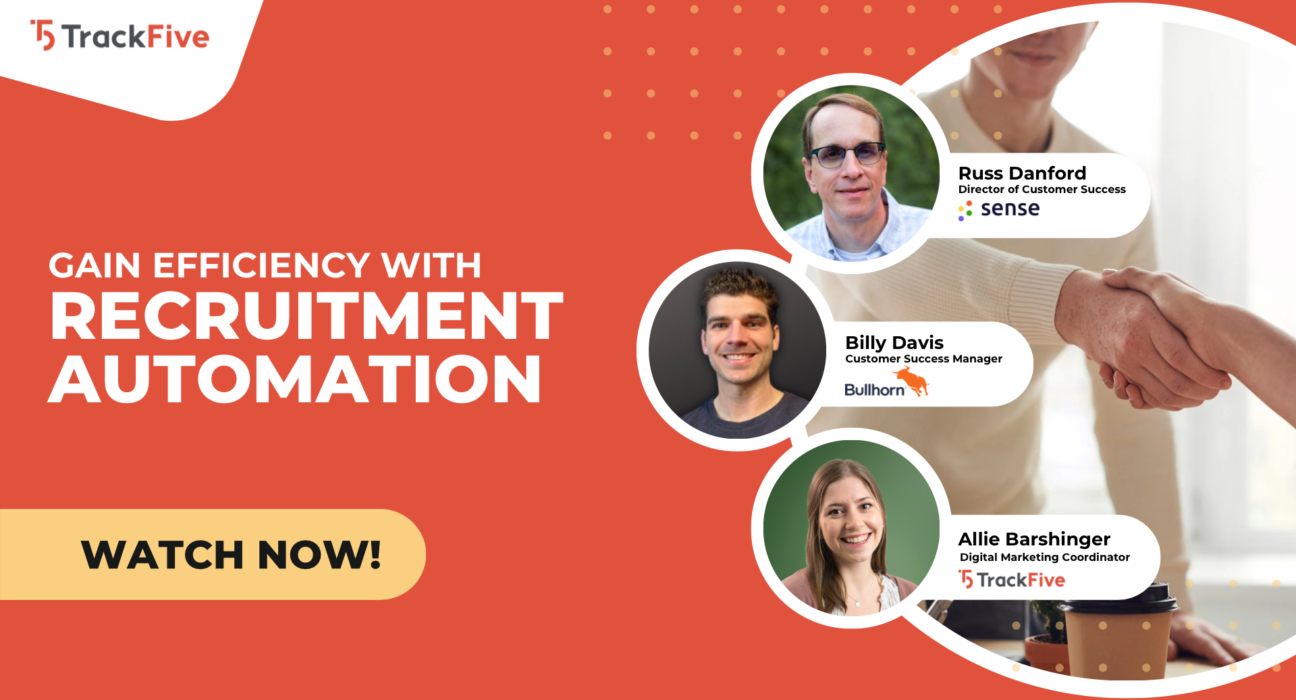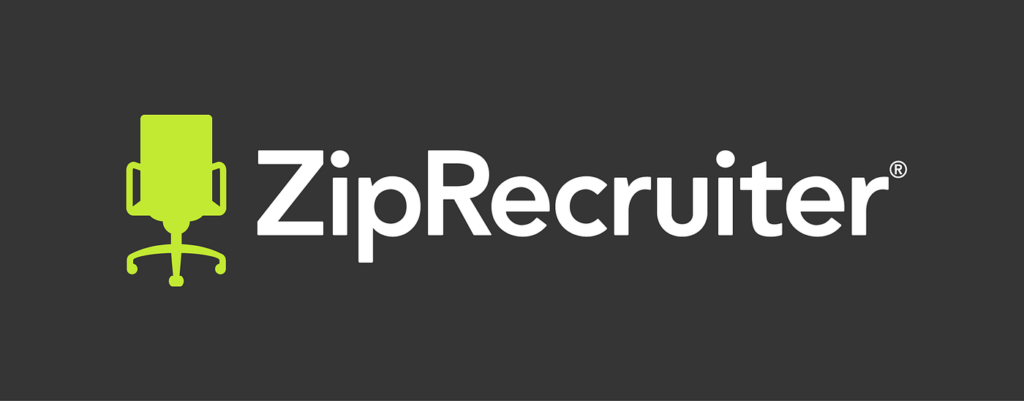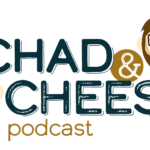Gain Efficiency With Recruitment Automation!

Title: Gain efficiency with recruitment automation!
Speakers:
Allison Barshinger – Marketing Manager – TrackFIve
Russ Danford – Director of Customer Success – Sense
Billy Davis – Product Manager, Automation and AI – Bullhorn
Nora Frumento – Account Executive – TrackFive
Allison:
Just wait a minute for more people to join. Hi, everyone. Thank you so much for joining this webinar on how to gain efficiency with recruitment automation. Before we get started, just wanted to make a few quick notes. First off, we wanted to just say thank you again for taking the time out of your day to join us. We love questions, so anytime, feel free to pop a question in the box there, and towards the end we will do some time for Q&A. And just so everyone knows, this is recorded and will be distributed afterwards as well. With that, we’re going to do some introductions. First off, my name is Allison Barshinger. I am the digital marketing coordinator here at TrackFive. And joined today, we have Russ Danford from Sense, and Billy Davis from Bullhorn. So thank you guys so much for joining. We’re so excited. And I’ll pass it to them to introduce themselves.
Russ:
Sure. I guess I will start off. First of all, thank you all for joining us today. I, again, am Russ Danford. I’m the Director of Customer Success with Sense. Just a little bit about my background. I’ve really been in the recruitment and TA world for over 20 years. Really spent most of my career in staffing. About 19 years with one company—Matrix Resources, based out of Atlanta, Georgia, which is where I currently live. And have done pretty much everything that there is to do within that realm. I started as a recruiter. I ran recruiting teams, I managed our marketing team for a period of time, and then got very much involved in kind of the technology aspects of it. And actually was a Sense customer for about four years before I decided to make a transition, do something different, and came over here to Sense.
Allison:
Awesome.
Russ:
It’s a pleasure to be with you today. Thank you.
Allison:
Awesome. Thanks so much.
Billy:
Yeah. Hi everyone. Billy Davis here. So my current role, I’m on the Enterprise Team at Bullhorn and Customer Success for Automation and AI. I’ve been at Bullhorn for three and a half years. I came over to Bullhorn from the Herefish Acquisition. Was the first full-time employee at Herefish. And then like Russ, before being an employee, I was a client and actually I was an early Sense client as well back in the 2015, 2016 days. So I’ve been automating and staffing, going on eight and a half, nine years. Done hundreds of implementations, worked with thousands of clients. So a big passion of mine is distilling some of that experience and helping those that are a little bit earlier in their automation adoption avoid some of the mistakes, adhere to some of the best practices and achieve the results that they’re after. So, really excited to be here.
Allison:
Awesome. Thank you both so much. On today’s agenda we’ll be talking about all things automation and the recruitment industry, efficiency in that space, and asking some tougher questions as well, such as how can recruitment automation create efficiency? Does automation hurt the recruiter’s skillset? And where do we see recruiting in the next five years with automation? Now for those of you who may not be familiar with TrackFive, I want to take a minute to pass it to Nora, our account executive, for a brief introduction.
Nora:
All right. Hi everyone, my name is Nora and I’m an account executive here at TrackFive. It is my pleasure to introduce the company. We all know how difficult it can be to recruit, especially these days. So that’s where we come in. We are a digital media and marketing agency located in Lancaster, Pennsylvania. We create recruitment platforms that connect healthcare, staffing agencies and trucking companies with qualified candidates. Under the TrackFive name, we have all truck jobs and AdElite for carriers, as well as travel nurse source, allied travel careers and locum jobs online for healthcare staffing agencies. Our platforms work to bridge the gap between your open assignments or empty seats and then top talent. We’ve been in these industries for over 15 years and have become a trusted name in the game with well over 800 clients. We’d love to partner with you and your team as well. So give me a call. I’d like to chat with your recruiting needs. I’m eager to learn more and see how our platforms can help fill in the gaps. Thanks again for joining us.
Allison:
Great, thanks so much, Nora. Let’s go ahead and get started. First, I’m just going to run a quick poll. And that is, are you currently using automation in your recruitment strategy? Let’s get started with Billy and Russ. So we’re just going to have an organic natural conversation here. But I want to learn a little bit more about Bullhorn and Sense as well, and how exactly, your product, and what it does to gain efficiency. So Billy, would you like to go first this time?
Billy:
Sure, yeah, I’ll kick things off. So Bullhorn Automation, the main idea is, it’s a “clicks, not code” kind of product where you’re able to automate all things within the recruitment lifecycle in your system. So thinking of it from “if this, then that” perspective. So “if this” would be the trigger, and “then that” is the automation action that you want to happen. So there’s lots that you can do. I typically say you’re pretty much only limited by your imagination, but obviously there’s lots to be gained from kind of a communication and engagement perspective, whether that’s email, text messaging, surveying, chatbots, et cetera, getting more engagement with your database. Then you also have kind of the aspect where you can increase your data quality. So making sure that records in your system are up to date, you have accurate information. Of course, marketing’s best friend is a quality database that you can segment and do some really nice campaigns with.
Speaker 5:
No doubt.
Billy:
So the data quality piece is, I know, really important, especially on the marketing side. And then lastly, it’s a huge kind of productivity tool to help recruiters know what to do, when to do it, and how to do it. So kind of lining up tasks or notifications to give them alerts when key things are happening or not happening inside of the recruitment life cycles so they can stay on top of everything that they need to do; but kind of manage their day-to-day with a little help so they can do everything they’re supposed to at scale, which obviously if you’re doing it manually, becomes a really difficult task.
Speaker 5:
Yeah. Wow. What about you Russ?
Russ:
So, I’ll take a little bit of a different tack in terms of explaining what Sense does. We do many of the same things that Bullhorn Automation does. We’re definitely a full talent engagement and communication platform. So from SMS and email to WhatsApp to chatbots, the whole gamut. But if you think about it from an efficiency perspective and you think about it as a candidate, and what is the experience like today for a candidate working with a company that doesn’t have automation? What does that look like? And I think we’re all pretty familiar with it. They’re going to spend time doing research, they’re going to ultimately end up applying for a job either directly on a job board or directly on an employer’s website. And then there’s this period of kind of “hope and pray” about what’s going to happen next. And it’s very disjointed. A lot of it depends on what recruiter happens to be looking at the database at what time. So maybe they get lucky and that recruiter is on top of things and sees their resume right away and reaches out and it’s a great experience and it happens organically and very quickly. But in more cases than not, given the volume of applicants that are coming through ATS systems today, that’s really not the experience that they have. And there’s a lot of back and forth that happens, even if that recruiter is really interested in engaging with that candidate. If that candidate’s a travel nurse, for example, or they’re a truck driver, they’re just not available maybe at the same time that the recruiter is to connect. So you get all of this friction that’s created in the process, and all the back and forth that happens, all the time that’s wasted. And really what our platform does is smooth that out. So we’re engaging with a candidate immediately after they apply. A lot of our customers are leveraging our chat bot, so they immediately get an SMS or an email and they can have a chatbot conversation. They can actually answer pre-screen questions to qualify the person. If they’re qualified, we can do an immediate handoff to the recruiter right at that point so the recruiter can pick up that conversation, or if they want to schedule a time to meet, that’s better for them, they can actually set an appointment right then and there. So just looking at it from really at the top of the funnel, there’s a whole lot of efficiency that’s created just on that end. And then when you look at it at the recruiter desk experience, they’re spending way more than half of their time doing things that are not talking to a candidate. When I was a recruit recruiter, I probably talked to candidates 10 or 15% of the time. And what we’re trying to do is to make it so that the automation piece sets the table for them; when they come in, they know who they’re going to talk to, they know that that person’s relevant and they can have a meaningful conversation, build a relationship, build trust with a candidate, which is what really the recruiters are paid to do. They’re not paid to schedule meetings and send out emails and spend tons and tons of time sourcing and that type of thing. So that’s really how I think about Sense—how we think about Sense as a company and really where we’re creating efficiencies across the candidate experience, both for the candidate themselves and for the recruiter.
Allison:
Yeah. Well, I love what both Bullhorn and Sense is doing here in this space, trying to make automation more simple and easier for everybody to use. Now, I know that we all love automation. We are driven to see where that continues to go. But would either of you say that there’s limitations of using automation in the recruiting process? If there are any, what would those be?
Russ:
Yeah, I’ll jump in, since Billy answered the last one first. I mentioned trust and interaction. Engagement between the recruiter and the candidate. That’s the piece that you can’t or shouldn’t completely automate away.
Allison:
Yeah.
Russ:
The candidate needs to understand and build a relationship with the recruiter in order to feel comfortable in terms of moving forward. There’s a certain component to that. And the automation piece can make that smoother. It can make that handoff happen in a way that’s much more efficient, like we just talked about. But it can’t replace the actual human interaction piece. And then just talking more broadly about automation in general, the challenges that we see that customers have with automation oftentimes rely or fall back to their data. And so if the data in the ATS or the system of record isn’t very good, automation isn’t going to be as effective as it could be. And in some cases it could be damaging. Because if you don’t have the right information on a candidate’s record and you’re sending out information to them that’s not relevant, you call them by the wrong name, as an example, then that’s certainly a limitation of automation. But it’s something that can easily be addressed. It’s just a matter of getting the data right. So that’s a couple of things I can think of.
Allison:
Yeah, the data, I would say, is definitely a hardship that I’ve experienced. It’d be so useful, but man, when it messes up, it is a little bit like, oh, that little personalization could have been ruined at that moment. What would you say, Billy?
Billy:
Yeah. Those are all great points by Russ. I think, the piece around data quality; also what we see is, if you have kind of siloed parts of your business—I think marketing is extremely apt to be kind of siloed in a third party system, whether it’s kind of a top of the funnel, kind of different tool. If you don’t have that single source of truth, that’s where you can also run into problems where you don’t have your two systems talking to each other. So you might have a marketing campaign that’s happening, but then it’s not reflected in the ATS or CRM. So then all of a sudden an automation trigger happens when it really shouldn’t. So kind of getting back to that integrity of process system data quality is a really important consideration to ensure you have kind of a holistic experience, that you’re designing without any flaws. And the other element that I would highlight is, I think, from a limitation standpoint, in my experience managing internal change management is something that’s really key because in the whole digitization journey from the staffing recruiting perspective, there’s lots of things that are changing in the day-to-day of recruiters. So if you go too quick, too hard, it’s very jarring as far as changing goes, and you get a lot of resistance. So one of the things that we really focus on, and I know it’s a really good best practice, is to kind of maximize and master that change management side of things so that your recruiters are excited about what automation is doing and they don’t feel like it’s yet another project or technology that’s getting forced upon them, where they don’t have input control or they’re not seeing the benefit from.
Allison:
Yeah.
Russ:
I think that’s an awesome point. And I experienced it firsthand as I was implementing Sense with my recruiting team. You need to start with what we call the low hanging fruit: What are the pain points that everybody hates to do but they have to do anyway, or maybe they aren’t really doing, but they really should be doing? And you get those in place and you start to get little wins. And then what I noticed—and it happened over a longer period of time, it wasn’t immediate, but then the recruiters started thinking about, “Well, hey, can it do this? Can it do that?” And that’s when it really starts to build and you get that traction and buy-in and cooperation among the whole team to really build out that experience and help them help themselves. So it’s really cool.
Allison:
That brings up an interesting question. And I’ve seen this just on different platforms, conversations happening. It can be so beneficial to recruiters, but do you think automation itself hurts the recruiter’s skillset? Is it taking anything away? I know we talked about the personalization tag point and some other things, but do you think it’s going to limit the recruiters and their desire to add that personalization?
Billy:
I’ll go first on this one, Russ.
Russ:
Yeah, go ahead. Yeah, no, that’s alright.
Billy:
Yeah. Pass the baton. So I think—and this is always what I harken back to—automation is a tool. So it just depends on how it’s getting leveraged and used. So your job as a company executive or leader deploying automation is to ensure that it’s getting used in the right ways. I think automation, when it’s done in an ideal environment, it takes away those kind of mundane or manual tasks that recruiters either don’t like doing or don’t have time for, to free them up for the higher value, kind of consultative relationship building approach, like Russ mentioned earlier. So I think that’s where if you do things correctly, it actually amplifies really the recruiter’s impact and skillset. Because it gives them more time to do the things they really want to do. I’ve never really met a recruiter that enjoys data entry, for example, but if they can kind of influence and provide some good insight or career advice, that’s typically what they got into recruiting or really enjoy about it. And then lastly too, from the recruiting side of things, this goes back to—I remember when I was a recruiter—really you’re also concerned about the bottom line. Is a tool or is something going to help you be more efficient, make more money, make your job easier? So if you can kind of do those things with automation, then the recruiters obviously are going to be on board and be quite happy with it.
Allison:
Yeah. You carry a lot of insight on that, just from having the recruiter experience yourself. That’s interesting. Russ, what would you say about that?
Russ:
I think everything Billy said was spot on. I think, ultimately, automation, if done properly and effectively, should only enhance the recruiter’s most valuable skillset. And that again, is building that relationship, building trust, serving as a trusted advisor for the candidate. I think the thing that we all have to be aware of with automation is to not get too complacent about it, to understand that we still need to think critically about when and where and how we use automation. Even if we’re getting recommendations in terms of, hey, these are the candidates that are likely the best fit, make sure that you’re looking at those to kind of validate that and test that before you do a mass outreach. Those types of things, it would be pretty easy to kind of fall back on and maybe not be as diligent as you would otherwise. So I think that’s probably the only significant risk that I see in terms of recruiters leveraging automation effectively.
Allison:
Yeah, I agree. So to get into more of the gaining efficiency with automation, let’s start it out by asking: How does automation, again, just to help the recruiters, and then what efficiency do you see automation bringing to the table, and how to make it more efficient for everybody’s use?
Russ:
Sure. I guess I’ll start on that one. The first thing, which is kind of table stakes with our customers that has been just extremely valuable for recruiters is messaging. And I think everybody now messages candidates because nobody picks up their phone. I don’t pick up my phone.
Allison:
I don’t either.
Russ:
If it’s a number that I don’t recognize, not going to pick it up. And my email inbox has gotten to the point where I don’t pay as much attention to it as I really should. So SMS—just starting out, our tool allows recruiters to be able to do one-to-one messaging, but also to be able to do messaging at scale. So as they’re out there either identifying a list of candidates that may be a good fit, or they’re actually getting recommendations on candidates from the AI: “Hey, here are some good fits”; they can reach out to them en masse. And obviously you need to be careful about how you do that. You want to make sure that you’re not over-communicating and hitting the same people over and over again, or you’re not communicating to too many people. But that’s like step one. And then from that, there’s a myriad of other things. There’s all the little touch points that have to happen with a candidate in terms of sending updates about, “Hey, you’ve been submitted to this job, here’s what the status is of that”. All these things that recruiters should do—and most of them do, but a lot of times you’re really busy and you don’t have as much time as you’d like to; sometimes you forget. So again, that creates a negative candidate experience. We can automate that—and we do, and that creates a ton of efficiency, it creates a better experience for the candidate, saves the recruiter tons of time, and just makes everything work more smoothly. Beyond that, I mentioned scheduling; that’s another thing. Anybody that’s tried to schedule a meeting with anybody—much less, if you’re trying to do it with two or three people, that’s where it gets really hairy—but just the time savings from being able to automate the meeting schedule part of it, is massive for recruiters.
Allison:
Can you go into a little more detail about how that works?
Russ:
Yeah, absolutely. So with our platform, there are a couple of different ways. We have a tool that’s called Scheduler, which is built into the platform. And basically every recruiter has a link. And that can be sent out in an email. It can be used in your email signature. It can be sent out via SMS. And basically it allows the candidate to click on that, view the recruiter’s calendar, see what times are available. The great thing about Scheduler is, a recruiter can choose the windows of time that they want to make available. You can even do round robining if you want to have multiple recruiters on a team, be able to essentially pick up, “Hey, I have free time”. The person can just choose a time that’s available on any of the recruiter’s calendars. So there’s a lot of flexibility there. Again, you eliminate that back and forth, “Hey, this Tuesday I have 2 o’clock and 4 o’clock and 4:30. Did that work? No. But I can do Wednesday”. You guys all know what that’s like.
Allison:
Yeah, the long email thread.
Russ:
So, that in and of itself is just massive time savings. And we get into the chatbot, and we have customers that are using our chatbot. A lot of it is for after-hours so when the recruiters leave for the day, the website’s still open for business; they’re still collecting resumes, they’re screening those candidates overnight and basically notifying the recruiter either via an email or it’s scheduled on their calendar so that when they come in the next day, they already know who they’re going to talk to. And in some instances, our recruiters, or basically everything, is being done—as far as the scheduling—in an automated fashion. So they know, as soon as they come in, this is what my day is. And they didn’t have to do any of that. So huge efficiency, time savings, just from that. And I’ll shut up and let Billy go because I know he’s got some good stuff too.
Billy:
No, all great. I’ll just echo—and we’re seeing similar results and people getting really excited. So our scheduling gets used very robustly. I’ll make the warning to everybody that once you go to that element of dynamic scheduling, you’ll never want to go back to, “When are you available?” “I’m available these times.” And the beauty is obviously you can link your own calendar so then you can get automatically for you, what are times that you share in common that are available for both of you, which is really helpful. But especially on the recruitment side where you’re doing a ton of screenings or around job applicants and things like that, getting efficiency in that is massive. Another area that we see great efficiency gains are in that job application process. From the recruiting perspective, you’re incentivized and your effort goes to working the candidates all the way to placement, to the offer, negotiating that, making sure everything is in place. Because that’s where you get your commission, that’s where you’re compensated from, and obviously that’s what your client is after; they want to get that placement. But then all the individuals that get left behind, whether they were sent out to the client and then they weren’t selected, whether they were interviewed and weren’t selected, whether they applied to the job and then they just weren’t a good fit, those are the folks that typically get left behind, especially from an experience perspective, like Russ mentioned. It’s not a good look for your staffing organization. But you can deploy automation to fill in those gaps and plug those holes and then ensure that all of those individuals are getting notified, getting engaged, pointed back to the website to look at additional jobs, getting feedback. And those are the things that really not only increase efficiency, but then also increase your reputation as a staffing company, which is massive. And then the last one I’ll mention is around just some of the enhancements that you can do on the pre-qualifying and pre-screening side, because from the recruitment side, if you get a hundred applications in for a job, it’s really rough to go through that manually and try to sift and sort. So if you can have some of that work get done for you, and you can target in on the top 10, top 15 that are passing a bare minimum threshold of: “They have relevant experience,” “They’re near the job location,” or whatever criteria that you’re setting, that’s really helpful to increase efficiency. And also obviously it gets your recruiters excited because they know the people they’re reaching out to, they’re contacting; they’re meeting a bare minimum threshold where the recruiter’s not going to be spinning their wheels, calling, spending five, 10 minutes talking to a person just to find out they don’t have the right background work, history, certifications, et cetera.
Allison:
Yeah. That’s awesome. Really helpful tips there. Now, when I talk about efficiency, just for myself, the first thing that comes to my mind right now is the big buzzword “AI”. I was on maternity leave and I came back in January and everything was AI.
Russ:
Yep.
Allison:
So how does that play in this game of automation? What can recruiters do to enhance that efficiency? And using all forms of AI, outside of just ChatGPT,
Russ:
You want me to take that, Billy?
Billy:
I can start. Yeah, no problem. I kind of break down AI’s applications in two main areas. So you have AI and machine learning around matching. So obviously the core component of recruitment is matching the right candidate with the right job. And there’s a lot that AI and machine learning can do to help expedite that process, make the quality matches, but then also utilize feedback from both the candidate, client and recruiter to continually enhance that matching and turn out those recommendations to help speed up some of the process. New job gets created, we can automatically make those recommendations for folks that are a good fit. So I think that’s a really strong use case and strong area for AI in staffing and recruiting. Then the other element that we’ve seen a lot of interest on is around the generative AI piece. So things like making a better and more compelling job description or job ad, updating a resume and getting information standardized in a good spot, helping with some of the outreach so the recruiters feel enabled that they don’t have to be a marketing or branding expert but they can still write and craft some of their own messages, but then also do things like even better personalization at scale and things of that component. So I think generative AI is a really interesting aspect. But then it’s funny too because both the matching and the generative, fallback on some of the core fundamentals of automation and digitization in general. For example, having strong data quality, you need both in place or your generative AI capabilities are going to be diminished. Your matching’s going to be rough if you’re not doing the right field to have the right information. And then the last thing that I will mention on this is another concern that we’ve seen, especially with the emergence of ChatGPT and other similar programs, is the concern around safety and compliance of the information in your database. So it can be very dangerous if your individual recruiters are copying and pasting your proprietary information in your database into an external AI engine to help you become more efficient. So a big component of what we’re doing on the AI front is in ensuring that all the AI elements are protected behind your firewall and behind your proprietary IP, so that you’re not coincidentally or accidentally building out the AI algorithms for your competition. Which is obviously the last thing you want to do.
Allison:
That’s huge. I’ll be honest, I wouldn’t have even thought of that. That’s huge.
Billy:
Yeah.
Russ:
So I’ll jump in. All those things that Billy said, Sense just recently released Sense AI, which is obviously our AI platform. We haven’t rolled it out to all of our customers yet. We have it in basically beta right now. I believe, in the next couple of weeks or so, it will be going out to all of our customers. But to what Billy spoke of, in terms of generative AI, that’s exactly what we’ve incorporated into the platform so far. So if you’re a recruiter and you’re using the Sense messaging platform, the generative AI will actually recommend content for you. It can write SMS messages for you if you would like it to do that. More importantly, for most of our customers, from a risk perspective, it will tell you if you’re writing SMS messages that are likely to get your line carrier-filtered—which if you don’t know about carrier filtering, read up on it because it’s really important, especially if you’re doing messaging at scale. So it can do that for you. But really we’re incorporating all of the AI components into essentially a digital assistant or a co-pilot for our recruiters, so that we’re going to give them the generative components within the platform in addition to what’s next, which we can talk about maybe in a few minutes. But as it stands out of the gate, we’re going to be offering recruiters and other team members, the ability to generate job descriptions; they’re going to be able to create tailored version of a candidate’s resume based on job requirements, summarize NPS survey information and data so that they can very quickly know and provide that up the food chain to the executive team; especially if you’re on the marketing side, that’s super important; better job recommendations. All of that stuff is literally here today. As I mentioned, this idea of the virtual assistant or co-pilot is coming very soon. I think Bullhorn’s probably very close to that as well. We both have a similar vision in terms of what that looks like, but basically you’re giving all of the power of AI back to the recruiters at the desk level. I will talk just quickly about our philosophy on AI. I agree with Billy a hundred percent. We don’t want to basically have recruiters putting proprietary company information into ChatGPT or something like that. We’ve partnered with a company, Anthropic, which is probably the second best known large language model producer out there. Actually, the people who started Anthropic came from ChatGPT and created GPT-3. And basically we have an interesting relationship with them where they’ve been helping us to build and train our models on staffing data, but we’re not sharing that data back with Anthropic, so our customers can know and understand that their data is not going to be used somewhere else to train somebody else’s model, but they’re going to get the benefit of everything that they do, interacting with the AI in the system. They’ll be able to say, “Yes, this is a good match.” “No, this isn’t a good match.” And that actually helped to train those models for that specific recruiter for that company. So lots of really cool stuff. I think it’s obviously exploded just in the last six months or so. What you’ll see in the next year is going to blow your mind. It will be a whole level above that. So, really cool stuff.
Allison:
I can only imagine what it’s going to be like next year this time. It’s come so far since January—even before that, really. If anyone has any questions so far for Billy or Russ and what they’ve just talked about, feel free to drop the questions below and we’ll get to them at the end. So as a marketer myself, I like to put my brain into a recruiter’s mindset: “What are they thinking about right now?” Especially with all of this change going on in automation and AI specifically. And I joined a lot of forums just to read discussions between recruiters and what they’re talking about. And I saw it was specifically on AI, but just as a whole here of automation, there was a conversation going about if this type of software is going to replace recruiters one day, and I just want to hear from both of you guys: What do you think about that question? And what would your answer be? Billy, we can start with you.
Billy:
Sure. The way that I think about it is, it depends on what type of recruiter you are. So if you’re a recruiter that’s just throwing things at the wall to see what will stick, you’re going to be quickly replaced because AI and machine learning and automation can do that much better. If you’re the recruiter that’s building relationships, that’s influencing, impacting, you’re safe. And actually, you’ll probably be even in more demand with automation and AI because like we’ve talked about a few times, that kind of people and relationship building side of things is always going to be an aspect of recruiting; especially something as integral and important in the life decision as changing jobs, that there’s always an element where you want to build that trust and authority with a person. And I think as technology advances, that likely is going to increase. So how I think about it is, if you’re a bad recruiter, you might have reason to be concerned about being replaced. Automation and AI will make you likely a great recruiter. And then if you’re a great recruiter already, your productivity and efficiency is going to go to areas that you’ve never seen before and you could never imagine. So I think that’s how I would answer the question. It’s a common fear of: “Are we going to get replaced by this tool technology?” And it’s also something that pretty much every new emergent technology comes with this disclaimer of the incumbent “Employees get really concerned, is this going to get rid of me?” Remember when job boards came out, recruiters saying, “Oh no, is this the end of recruitment?” And obviously we’ve seen recruitment survive. But then the other element too is, I think it’s going to open up a lot of opportunities, and then you’ll see different types of jobs. So speaking about the generative AI concept for a moment, we’ve already seen an emergence of prompt engineers. So ways to create prompts in AI to get the exact queries and output that you’re after. And of course, that didn’t exist six, 12, 18 months ago. So I think it’s going to be similar to that where there’ll be new opportunities that pop up. And obviously it’s also interesting, Russ and I share an origin story of both being recruiters and then moving into an operations role, then getting into technology. I think you’ll also see some of that, where recruiters that are interested in these things, that want to see improvement, they’ll have opportunities to move nimbly throughout organizations. And obviously it both helps Russ and I to go back into our recruitment days from all the things that we’re doing currently,
Russ:
And we need those people to move from the recruiter desk into the operations desk to help with these automations. That’s like a huge success factor in terms of companies being able to achieve their goals; having somebody knowledgeable and understanding of what the actual processes are; more importantly, what the candidate is dealing with and what they’re experiencing and what the recruiters are dealing with and experiencing. So I agree with that wholeheartedly, Billy. I think there’s going to be tons of opportunities for recruiters to move into different jobs, for those people who maybe are ready to do something different. But I also agree, I think that there are recruiters that will be replaced by AI. And honestly, five years ago, I’m familiar with a company here in Atlanta that had essentially replaced all of their recruiters with mass email and automation that way. And I think what you’ll see is for gig jobs and things like that. That’s probably where it may be fully automated. It’s like ordering an Uber or something like that. It’s quick. The time commitment on the candidate’s part is maybe not that long, and so there’s not a whole lot of risk and trust needed to be developed. And so I’m certain that you’ll see that. But broader scale, you’ve got a wide variance in terms of ages. I’m an older guy. I’m generation X, but just hit 50 this year. And I’m not like my kids, in terms of, I’m not as digitally adept as they are. And I know from my experience in working with candidates that some people just want you to pick up the phone and talk to them and there’s always going to be a need for that. So again, I think in some instances, AI and automation will certainly be able to amplify the recruiter’s ability to reach out to many more candidates. One thing I was always told as a recruiter is the size of your network or candidate pool that you could work with was probably 200 at max, because you just couldn’t keep up with any more people than that. And I think that’s sort of on a human scale. It’s like you can group into groups of 200, and beyond that, it gets really difficult. Well, with AI and automation, you can expand that three, four or five times and be able to have meaningful engagements, get notified when it’s appropriate for you to have a human to human interaction, and be able to keep in contact with a much larger group of people. So one recruiter can have a much larger impact within an organization than maybe they can today. So, totally agree. I think recruiters are here to stay for sure. And the job’s just going to get that much more interesting and exciting for them.
Allison:
Yeah, no doubt. I’m glad recruiters are here to stay. But I do agree that, that personalization aspect is never going to go away. Even with the growth of automation and AI, everybody is going to want a little conversation; we want that human interaction, and I think that’s just a natural desire for everybody at some points. So we talked about efficiency using messaging, scheduling, AI. Is there anything else that you guys see now or possibly in the future that will be useful for recruiters in the automation space?
Russ:
My big prayer that has not been fully answered yet is that we figure out a way that we don’t have to continue to do degree verifications and those types of things manually. And I do believe that day is coming. I don’t know if that’s a blockchain solution or what, but I think as we start to move into more of this Web3 environment, as they call it, we’re going to be able to own our own data, and we’re going to be able to give access to people as they need it and as we approve of it. And I don’t think you’re going to have a situation where there’s somebody in a staffing company office having to pick up the phone and call University of North Carolina to verify Russ Danford’s degree every time I interact with a particular employer. I think that is going to go by the wayside, and I cannot wait for that day. I know the people in the back office who are doing those things. Can’t wait for that day to come. So that’s one example I can think of. Billy, I’ll toss it over to you. I’m sure you have something, and maybe we can go back and forth on this.
Billy:
Yeah. And it’s cool because I think one of the things that we’re recognizing is, there’s going to be so many emerging new technologies, new items out there. So a big part of what we’re trying to do with Bullhorn Automation is to be the automation engine for the whole bullhorn marketplace and ecosystem, so that if you have partners that specialize in certain industries or use case, you can have an automation layer automatically because of the tight integration. So that’s what I’m really excited about, because there’s so many good things happening technology-wise in the staffing industry, but then the age-old problem of “you need everything in the one spot, one place”—solving that single source of truth, I think unlocks a lot of powerful combinations, collaboration opportunities.
Allison:
So good. Excited to see where this goes.
Russ:
The big thing I would say is, everything that’s coming out today and that you’re just starting to see, is going to be superpowered. I think when we first started building our chatbot solution, it was really just an automation tree. It’s the “if this, then that”—as Billy said earlier; and that was helpful, but it’s not what people want to be able to do. They want to have choices. And if you’re engaging with the Sense chatbot, maybe you want to ask a question about: “What are the benefits of Sense?” Or from the particular employer, “What are the benefits this employer offers?” And then you may want to change things up and ask something completely different. And you don’t want to get essentially stuck where you can’t move forward. And already, we just released our version 2.0 of our chatbot that has much more powerful natural language processing. We have some additional things that are just coming out in terms of being able to do handoffs between different bots so that you can have more of that experience that you would have with ChatGPT. It’s still siloed within the company’s data. They’re not going out there and asking about who’s going to win the next election or something like that. It’s probably not going to provide them an answer to that. It’s going to be relevant to the company and the things that the company wants to have available for that candidate to ask about. But it’s just going to be a much more fluid experience. We envision this world where everything is truly omnichannel: Your candidates can move between SMS, email… Just lost my mind there for a second. Between email-
Billy:
Yeah, chatbot, SMS, email.
Russ:
Chatbot. Thank you. I was thinking of WhatsApp and I just could not get it out my face, for some reason. But WhatsApp, between any channel they want to. And they do it fluidly. It’s not a break in the communication chain. It’s a constant. It’s a continual. And that’s really where we see all of this going. And not just on the candidate side, but also again on the recruiting side, and being able to basically give them a dashboard or a cockpit, that they walk into the office and everything that they need to know about what’s going on and what’s most important to them is right there in front of them. They know who they need to reach out to. They just had an NPS score that came in that was really low for a particular candidate that just started an assignment. “I need to reach out to them and find out what’s going on.” Boom, it’s right there on your dashboard. Those types of things are here, essentially. I think it may be a little bit clunky to start with. I think we’re all working towards that. Things don’t just come out of the box and it’s amazing, but that’s where I think we all expect to be in the very near future.
Billy:
Yeah. And I would echo that. And I think, seeing the consumer experience shift in all other areas of life, I think that level of expectation and delivery will make its way into staffing and recruiting. So I order food through an app, I get a play-by-play record of, “it’s been received,” “it’s getting prepared,” “it’s ready for me.” I drive up, they know who I am, they have it ready to go, I grab it. I order something online, I can check out reviews, I see when it’s in the warehouse, when it’s en route, when it’s at my front door, I get a picture verification, there it is. So all of these experiences that we’re getting in other aspects of life, I think is going to shift the expectations on the staffing and recruiting side. So it will no longer be acceptable when I apply to a job, and I don’t hear back anything; I get ghosted, I don’t hear anything.
Allison:
Which is so common, unfortunately, right now. It’s terrible.
Billy:
Right. And all these other aspects of the consumer life, we’re getting faster, more nimble, getting instant status of where we are in the process. So I think recruitment obviously has some way to go to get there, but I think that’s where it’s headed in the near future; is to be able to provide a seamless and similar experience to ensure that you’re not creating this chasm experience gap between what you achieve in other areas of your life compared to what you’re doing when you’re trying to find a job.
Allison:
Russ, were you going to say anything?
Russ:
No, I agree. I think—and this is not a knock on the staffing industry—staffing is like “prove it to me, show me”. And so from a technology standpoint, you typically find the staffing world is maybe five years behind, maybe a little bit more than some of the corporate world in terms of technology adoption, but it is happening. And the interesting thing is that when the switch finally gets flipped, it’s a flood. I implemented marketing automation in the staffing company that I worked for probably eight, 10 years ago—and one of the first to really do that for the size company that we were, but we were essentially the only people doing it.
Allison:
Wow.
Russ:
And it was a story that continued to develop over the years. You started to hear more and more conversation about it. Obviously, companies like Sense came online and started to provide that as a service for staffing, but then it’s really blown up. And I think COVID obviously helped to move things forward a bit faster than maybe they would have otherwise. But since that time it’s just been a bit of a freight train in terms of everybody understanding, “Oh wait, I have to do this to compete.” And not only to compete, but also to provide an experience—for the candidates—that are going to keep them coming back.
Allison:
Yeah. So as we wrap up here, I’m interested in Bullhorn and Sense, and I want to open up a discussion here. Near future, as we talked about, where do you guys see your product going in the next five years? I know that’s a loaded question because everything changes day to day, but as of right now, in this moment, where do you see your product in the next five years?
Billy:
Yeah, I could start. Previous to my current role, I was in our product team. I was our product manager for everything automation and AI, so I can give you some insight on how it goes. Typically, roadmap-wise and product-wise, you’re looking at 12 to 18 months; usually is your long roadmap items, just because things are changing so dynamically in the market as far as needs. And especially if you talk about AI, you could have a whole shift of value props and use cases in that timeframe. So I think the biggest thing that we’re seeing is the ability to be nimble and agile to ensure that we’re being responsive to trends and needs in the market, staying close to clients and market analysis and data to understand, “Where are those shifts happening?” “Where are the gaps?” “Where does that product need to be?” And then ensuring that we can be the automation engine for everything in the Bullhorn ecosystem so that we can power and partner with our marketplace partners; anything that’s happening in the system can potentially be a trigger or utilized in the automation world. Those are some of the key elements, I think, where we’re focused on delivering. The specifics of how that shakes out, obviously will get revealed in due time, and then obviously those things ebb and flow depending upon those that product market fit, and what are some of the challenges that need to be solved in the near term or midterm.
Allison:
Yeah.
Russ:
Yeah. And from a Sense perspective, I’ve alluded to this before, but I think this idea of virtual assistants or co-pilots is probably at the forefront of what we’re thinking about in terms of engagement. Just being able to bring forward all the data that’s in your ATS and make it make Sense for the recruiter, make them more efficient, show them what’s important, on a daily basis, and basically give them the time to have those meaningful conversations, build those relationships to do things that are going to drive dollars in their pocket and revenue for the company, that’s really a huge part of what our focus is right now. If you look beyond, beyond a little bit—and I don’t think this is that far off—I think you’re going to have a world where everybody’s going to have their own virtual assistant. So the recruiters will have their assistant and the candidates are probably going to have theirs too. And you’re going to get to a point where you’re going to have assistants talking to assistants and having a lot of this stuff done upfront without a human ever being in the mix, and based on the individual’s preferences about what types of jobs and compensation and all that stuff. And ultimately once some sort of negotiation happens and both of the assistants agree, “Hey, this is a good potential fit,” then the parties are brought together and the magic happens, and the recruiter does their job. And again, as Billy said, you can’t predict exactly when that is going to happen, but I think it’s almost assuredly going to happen. And it’s not going to be 10 or 15 years down the road, it’s going to be much closer than that. And that’s a big part of what we are trying to do; is just unify all the different ways that candidates and recruiters communicate, make it as frictionless as possible, make it as seamless as possible—just much more efficient for everybody.
Billy:
I think another interesting element too is—and obviously you talked about the history of Sense or the history of Herefish, it goes back now almost a decade, but really the industry is still in an early adopter phase. But also, not many in the industry realize we’re still in an early adopter phase because there’s been some pioneers that have gotten amazing results from it. And so everybody thinks that everybody else is at that level, when in reality, most people haven’t started yet, or if they have, they’re very early in their journey starting out. So I think that’s another interesting component where everyone is so concerned about everyone else racing far ahead, that they get almost some anxiety of “we’re too late,” when in fact we’re still in that early adopter phase. So I think a lot of the next couple years is going to be a rapid shift that moves from that early adopter phase to that early majority phase, where companies are in a similar boat where they’re getting these things set up, they’re getting their house in order from a systems process, data quality perspective, and then they’ll be able to leverage some of the bells and whistles of automation, AI, and digitization, because they’ve developed that foundation.
Russ:
I think that’s a great point. I think we look at the companies that are on webinars like this, talking about their success with Sense or Bullhorn Automation, we go, “Wow, we’re completely behind the eight ball.” But we have a large segment of our customers that are doing it a step at a time. And they’re doing it purposefully, which is what we recommend. And Billy, you mentioned it at the very beginning, that you have to take these things in steps. You can’t expect to come in and do it all at one time, because the change management aspects of that, both from your internal employees, but also for your candidates, there’s a lot to get adjusted to. So I do think that there’s a maturity that still is happening within the recruitment automation space, but it’s come a long way just in the last couple of years for sure.
Allison:
Yeah. Wow, guys. Well, thank you so much. This has been so helpful. It’s amazing to get your insight. And you guys are in this space and obviously have a lot of history in this space, so getting your insight on all of this has been really helpful. I could ask so many more questions because I am, myself, very interested, but since we are close to the hour, I’ll come to a close. Oh, we do have a question. So this is from Kelsey: “We are a current user of Sense. Do you have an update on when the ‘Live Agent Transfer’ would be available?”
Russ:
Ah, that’s a good question. I think it is available now. I’m pretty sure. But if she wants to give you her email, I am happy to reach out after and just confirm that.
Allison:
Okay. Yes, Kelsey, I will reach out to you after this.
Russ:
And it may be only live in beta right now—that’s maybe what I’m thinking, but it is definitely coming out here in the next few weeks for everybody, if it’s not available yet. I apologize for not knowing; I should know that.
Allison:
It’s okay. You can’t know everything. I mean, you know a lot, it seems.
Russ:
We’ve got a lot of releases going on, so sometimes it’s hard to keep up with everything.
Allison:
Yeah. Guys, well, thank you so much for being a part of this webinar. I really appreciate your insight on everything in this conversation. If anybody has any questions for Russ or Billy, please connect to Sense directly or Bullhorn directly. And then if you have any questions for myself or Nora, don’t hesitate to reach out. But thank you guys again, so much. Really appreciate it. And I hope that we’ll be able to talk again soon.
Billy:
Thanks for having me.
Russ:
It’s a pleasure.
Nora:
Thank you.
Russ:
Thank you.
Billy:
Hour went by quickly. It’s a sign of a good conversation.
Allison:
It did. Thank you so much, guys. Have a good one.
Russ:
Thank you, Bill.
Billy:
Yep, take care.
Russ:
All right everybody. Bye-Bye.
Bye.
END OF AUDIO











